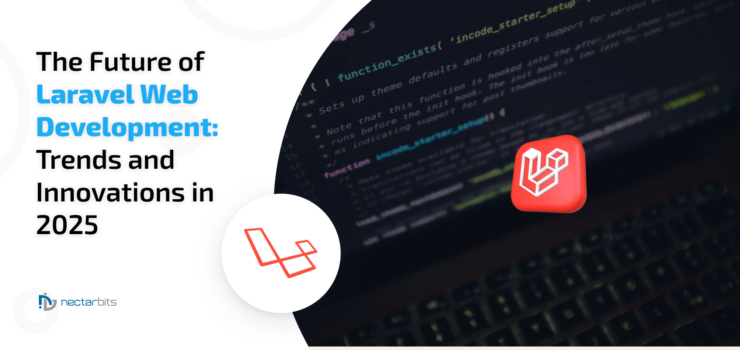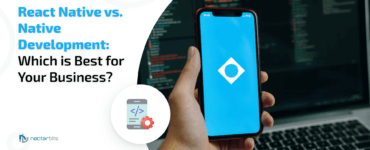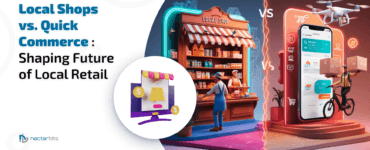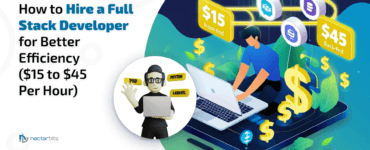Quick summary: Advanced technological innovations pave the way for business success. Adopting Laravel development trends is equally essential to succeed with Laravel web development. This blog will walk you through the top 10 trends that help businesses cut through the noise with Laravel web development.
Since 2011, Laravel- the PHP framework- has been continuously evolving and leading the position for modern web development. The developer-friendly features, simplified syntax, and extensive ecosystem make businesses leverage Laravel development services in Canada for scalable growth. With emerging technology and Laravel community contributions, Laravel is capable of meeting growing demands. The regular updates in Laravel till the 11th version are evidence of the same.
However, the support for Laravel 6 and 9 versions has ended, and we expect Laravel 10 support will be finished by 2026. The support for Laravel versions makes it essential for businesses to embrace the latest Laravel development trends to stay ahead of the curve. Nectarbits is a leading Laravel web development company that understands the importance of innovation in the web development landscape by embracing Laravel trends.
This blog will shed light on the latest trends and innovations that are transforming Laravel web development at scale. Let’s explore!
Top Laravel web development trends to look at in 2025
If you want to know more about how to innovate Laravel web development to maximise business efficiency and growth, the Laravel development trends reveal things in detail.
Microservice architecture
Laravel micro-service architecture is one of the popular Laravel development trends, and it is the developer’s favourite. It facilitates creating scalable app development by breaking apps into manageable services that are loosely coupled. Every microservice created using routing, controllers, and middleware is accountable for performing functions.
The microservices communicate with each other using APIS and discover other services using a service registry. The seamless integrations with both Docker and Kubernetes platforms help better manage micro-services. When microservice architecture grows, monitoring tools such as New Relic or Datadog help track the performance of microservices.
Serverless architecture
Laravel serverless deployment is widespread to reduce web app deployment complexity by a large fraction. Laravel enables building and running using a serverless architecture with the help of AWS, Azure, or Google Cloud services. At first, web apps are broken into smaller functions, and event-driven services trigger functions.
Database-as-a-service providers and storage-as-a-service providers are leveraged to manage databases and storage, respectively. Monitoring tools track the functions to identify unexpected errors and performance bottlenecks.
Real-time app development
Real-time app development is gaining traction, which facilitates instant updates to users and improves engagement. Initially, the real-time communication protocol is selected, and Laravel seamlessly integrates it. A real-time message broker is used to manage messages between the client and the server.
The event broadcasting system allows broadcasting events to the users in real time, and push notifications let them know about any changes. A real-time data synchronisation system ensures data remains synced between the client and server.
Cloud-native development
Cloud-native apps allow businesses to avail of the scalability, flexibility, and resilience that cloud platforms provide. Laravel supports building resilient apps that operate and run on various cloud platforms like AWS, Azure, or Google Cloud. The containerization platform, cloud database, and cloud storage services are used for cloud-native app development, and serverless computing services run the app’s code efficiently.
Laravel headless CMS
Laravel headless CMS is a growing phenomenon that allows developers to separate content from the presentation layer, which enables building agile, dynamic applications. Several headless CMS tools are available that e-commerce developers use at scale to manage product catalogue and user data at the backend without changing the frontend (Presentation layer). Headless CMS tools, including Strapi, Contentful, Directus, Cockpit, and Hygraph, are becoming more popular than traditional CMS tools.
Laravel AI integration
Laravel AI Integration is driven by an AI/ML-based app development trend that automatically improves functionality based on user behaviour and preferences. Based on the app’s need for intelligence, the ML library, prediction system, automation system, NLP library, and computer vision library are leveraged accordingly, which helps enable the functionality.
DevOps practices
Continuous integration and continuous deployment have been popular for decades. Laravel allows using DevOps practices that combine development and operations. Version control, automated testing, continuous integration, and infrastructure-as-code leverage are essential for implementing DevOps practices in Laravel development.
Low-code development
In the age of instant gratification, building applications at speed is possible with no-code platforms. Without writing a lot of code, Laravel developers can engineer intuitive interfaces and feature-rich applications. Laravel seamlessly integrates with a visual editor, code generator, pre-built components, templates, and APIS that enable building apps quickly with little to no coding.
Blockchain-driven development
Security and privacy are paramount in Laravel applications, which can be achieved with blockchain technology leverage. The distributed ledger technology integration requires blockchain platforms (Ethereum, Hyperledger, and Corda), leverage, blockchain API to interact with blockchain networks, smart contracts to automate functionalities, cryptography capability to verify transactions and consensus mechanism usage. It ensures all the transactions are secure and transparent and can never be tampered with by anyone.
GraphQL API
Laravel encourages developers to build and use Graphql API, which facilitates retrieving data only when needed and reduces network overheads, which, in turn, enhances the app’s performance. Graphql schema is leveraged to define the data types that the API can return, and the resolver system is leveraged for each Graphql schema to resolve the query. With the caching mechanism, the number of requests is reduced, which improves the app’s performance. The built-in validation system in Laravel ensures sensitive data remains safe and protected.
Why should you choose Nectarbits to make Laravel development future-proof?
At Nectarbits, our Laravel development team specialises in leveraging advanced tools, techniques, and trends that help businesses innovate and stay ahead. The team assesses the current business system before recommending the trends that improve website performance, security, efficiency, and engagement, which ensures businesses thrive in the digital space with Laravel development services. Also, our developers are upskilled in modern Laravel and with continuous learning, which allows businesses to tap their full potential and bloom their business with Laravel.
Conclusion
Custom web application development, that’s modern, user-friendly and professional, is a need of the hour. The voice of the market states that Laravel helps businesses dominate the web development landscape with its latest trends, including microservices, serverless architecture, AI integration, low-code development, and others. Collaborate with Laravel experts to create an impact in the digital space and grow your business cost-effectively.

FAQ
There are endless benefits of Laravel development trends adoption in 2025, including enhanced performance and scalability, improved security and privacy, AI automation, modern frontend integration, cost and time efficiency, better developers’ experience, and future-proof development.
To continuously evolve and stay relevant in the web development landscape, you should look for trends, including serverless Laravel, microservice architecture, AI/ML integration, headless CMS, security, and API-first development.
Yes, Laravel Development Company like Nectarbits find Laravel relevant for serverless computing because of the zero downtime deployment, cost-efficient scaling, and edge computing.
Laravel, with its continuous updates, wins the heart of the developer community and ensures the best development experiences with better IDE support, simplified deployment, and AI-driven debugging.
It seems Laravel will remain the #1 PHP framework in 2025 and the years ahead due to continuous innovation, a strong ecosystem of libraries, community support, and enterprise adoption.








